This post may contain affiliate links. Please see our disclosure policy.
Canning lemon curd is a delicious way to preserve lemons right on your pantry shelf. This luscious spread is delicious right out of the jar, but it also works well in all manner of dessert recipes, from cookies to tarts, between cake layers, and even on top of ice cream.

Lemon curd is one of those delicious spreads that just about everyone loves, but they rarely take the time to make. A jar of lemon curd makes the perfect gift for the holidays, and it’ll allow you to give tasty homemade love in a jar, much to the surprise and delight of your friends, family, and coworkers.
If you’re a devoted home canner, you know that lemon curd contains a lot of ingredients that generally aren’t approved for canning. Butter and eggs usually aren’t allowed in canning recipes, but this one particular recipe is so delicious and popular that the National Center for Home Food Preservation went out of its way to specifically develop a safe canning recipe for lemon curd.
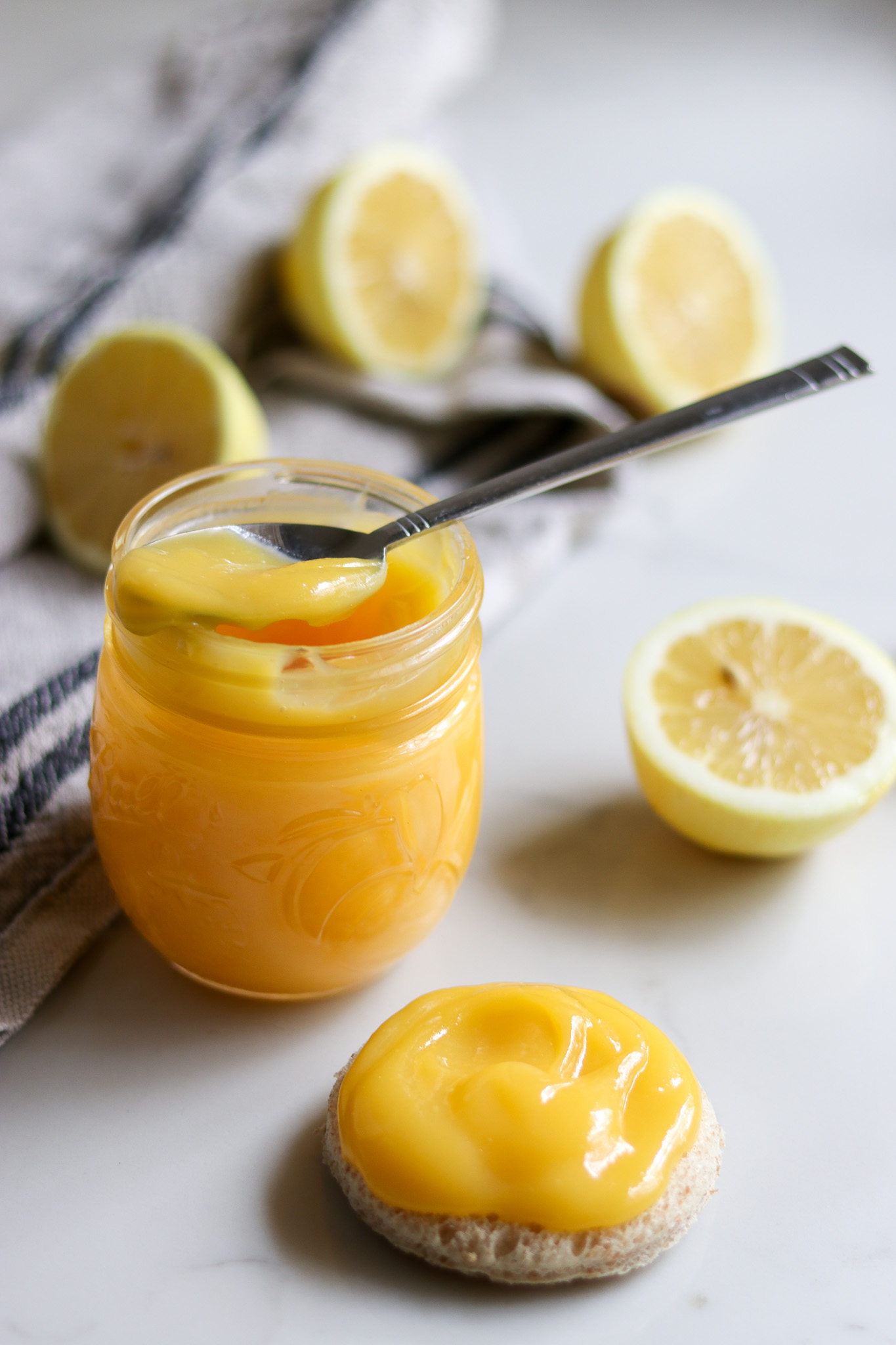
You cannot can just any recipe for lemon curd, it does have to be this particular recipe, but that said, this recipe is just about perfect and full of incredible flavor!
The fact that it can be safely canned means you can make it ahead of time for gift giving, and can it so that you can wrap it and put it right under the tree without a worry.

Ingredients for Lemon Curd
Homemade lemon curd has a beautiful flavor and consistency without added preservatives. The bottled lemon juice in this recipe creates enough acidity for preservation, and the sugar helps too. Do not decrease the amount of lemon juice or sugar.
Though this recipe also requires fresh lemons for the zest, you do have to use bottled lemon juice for safe canning in this case. The leftover juice from the fresh lemons can be used for canning lemonade concentrate (or strawberry lemonade concentrate), as that recipe is tested for use with fresh lemon juice.
When you’re canning with eggs and butter, you really do have to stick exactly to this tested recipe, so please don’t alter the proportions or use fresh lemon juice.
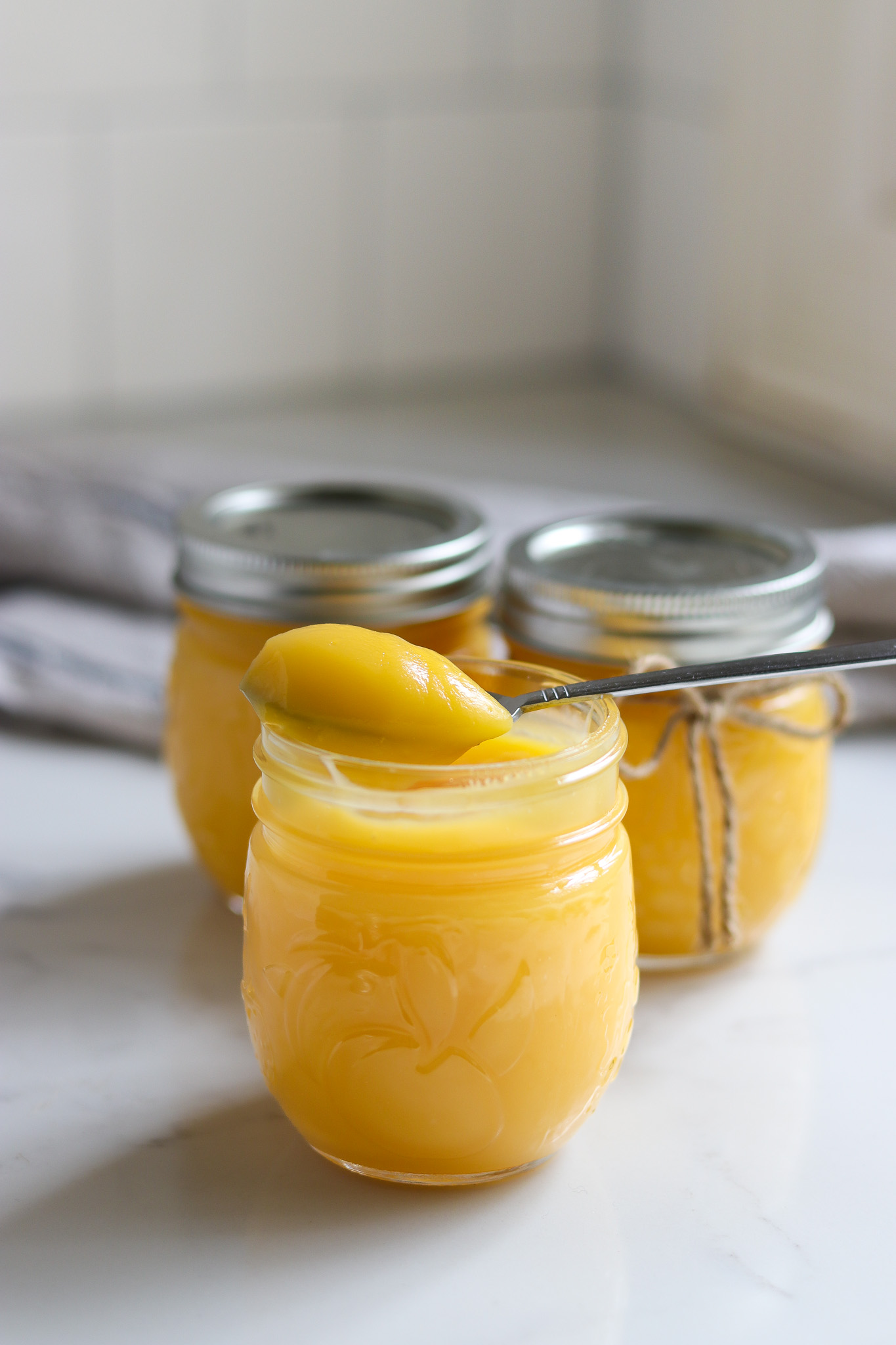
The recipe is a small-ish batch, making just 3 to 4 jars. Don’t double the recipe, as it might not cook properly. If you want to make more jars to have enough to gift, you do need to do multiple separate batches.
To make a batch of 3 to 4 half-pint jelly jars (8 oz each), you’ll need the following:
- 2½ cups superfine sugar (see below)
- ½ cup fresh lemon zest
- 1 cup bottled lemon juice
- ¾ cup unsalted butter, chilled and cut
- 7 large egg yolks
- 4 large whole eggs
Again, do not use fresh lemon juice, bottle lemon juice must be used if canning. You will also need fresh lemons for zest, as the zest really adds incredible flavor that makes lemon curd what it is. The lemon juice preserves it, but most the flavor is coming from the zest.
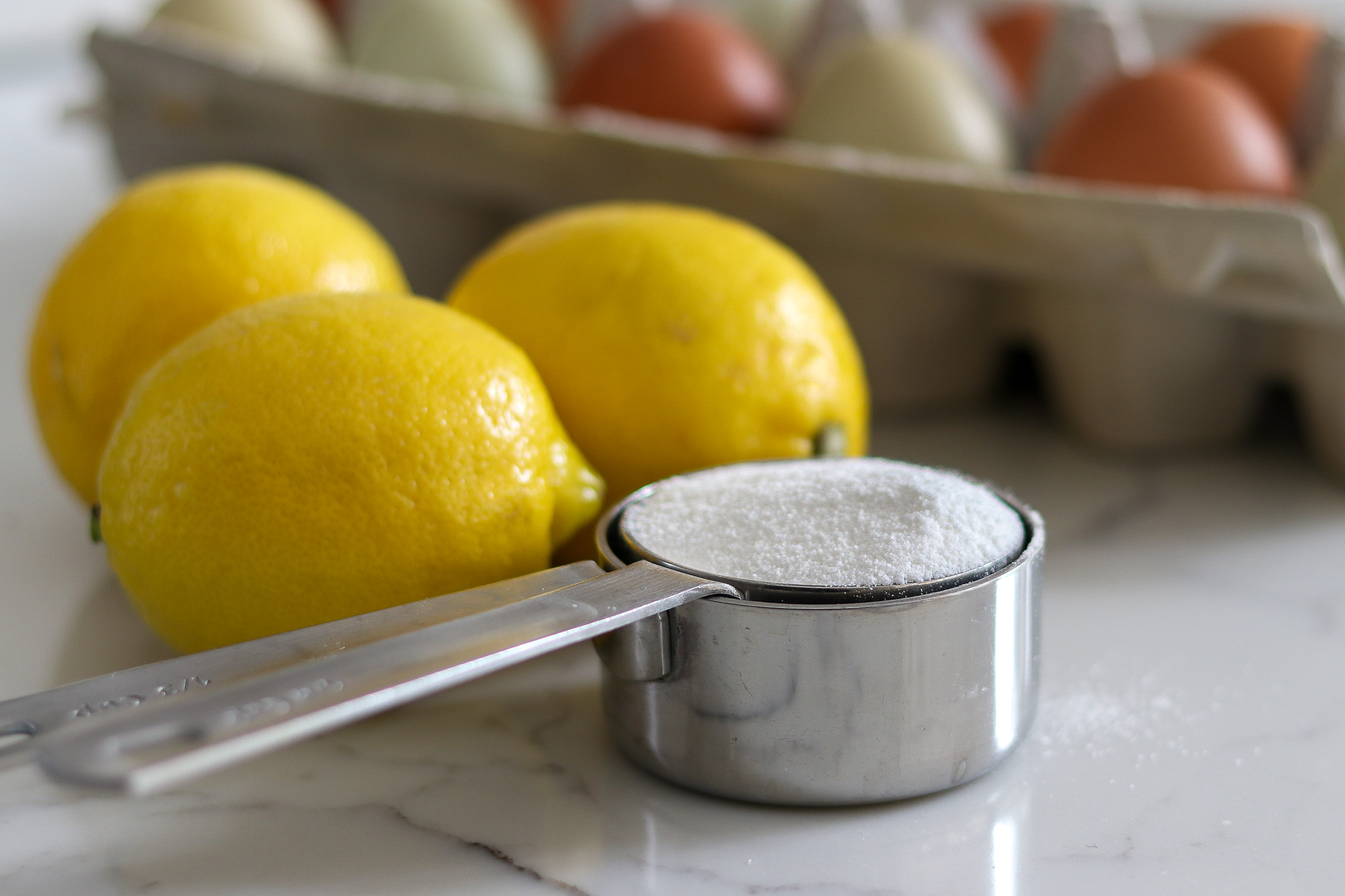 Superfine sugar is preferred in this recipe because it breaks down more easily when mixed with lemon zest.
Superfine sugar is preferred in this recipe because it breaks down more easily when mixed with lemon zest.
You can use a food processor and granulated sugar if you do not have superfine sugar. Do not use powdered sugar or confectioners sugar, as it has other ingredients added, like corn starch.
Add 2½ cups granulated sugar to a food processor and grind for 1 minute. Let the sugar “dust” settle, and use this ground sugar instead of superfine sugar.
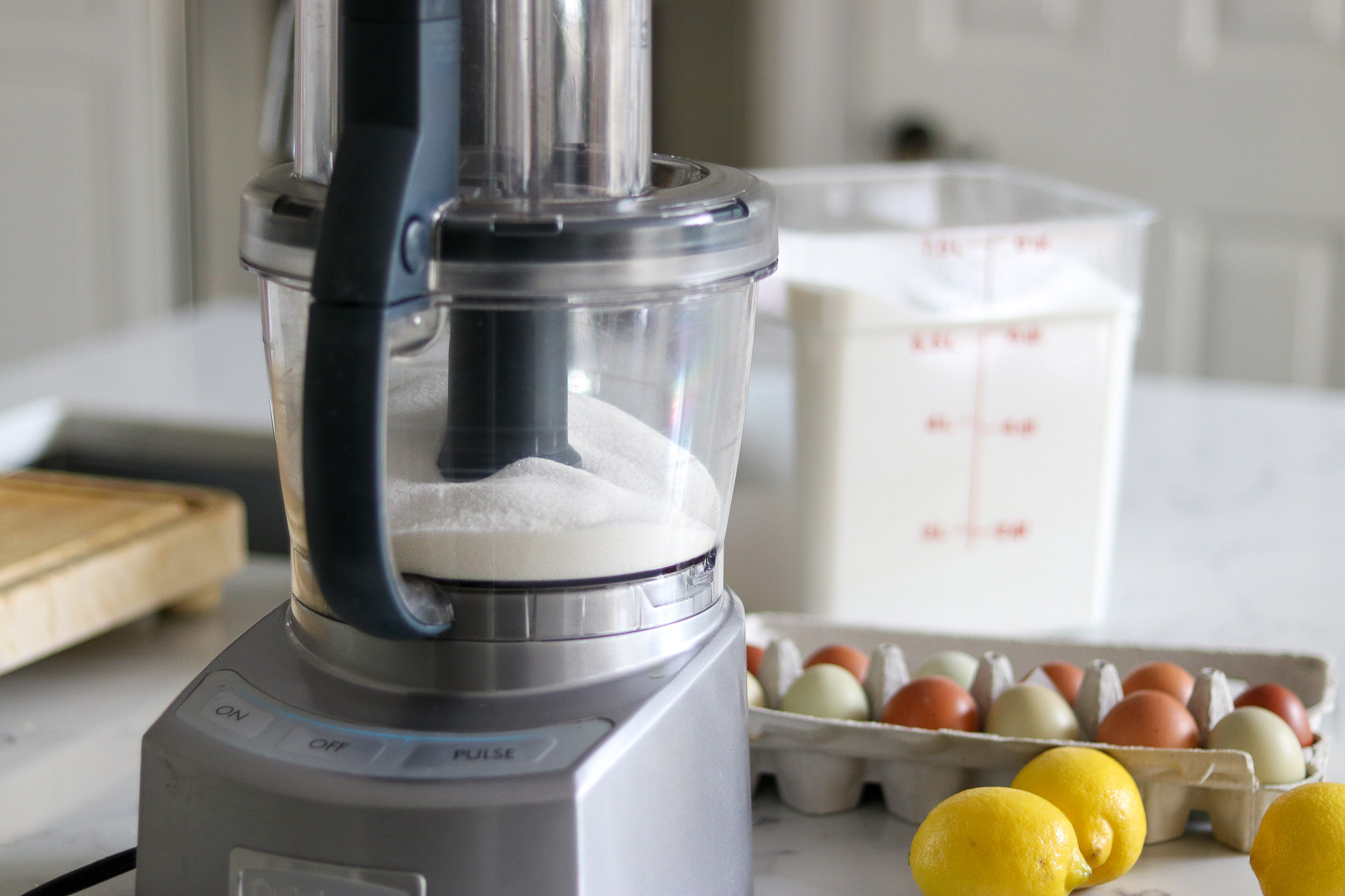
Fresh lemon zest is ideal for this recipe. On average, 1 medium lemon will yield about 1 tablespoon of zest.
8 tablespoons equal ½ cup, so you need 8-9 medium-sized lemons to get enough zest.
Even though the zest gets strained out after it is cooked, the intense flavor of zested lemon is essential for making delicious lemon curd.

You may be tempted to use the lemons you just zested to make the lemon juice needed for this recipe, but bottled lemon juice should be used.
The acidity level of bottled lemon juice is consistent, which is essential in preserving curds, jams, and jellies.
The juice from the lemons you zested can undoubtedly be used to make some fresh-squeezed lemonade or homemade salad dressing, but it should not be used for the juice required in this recipe.
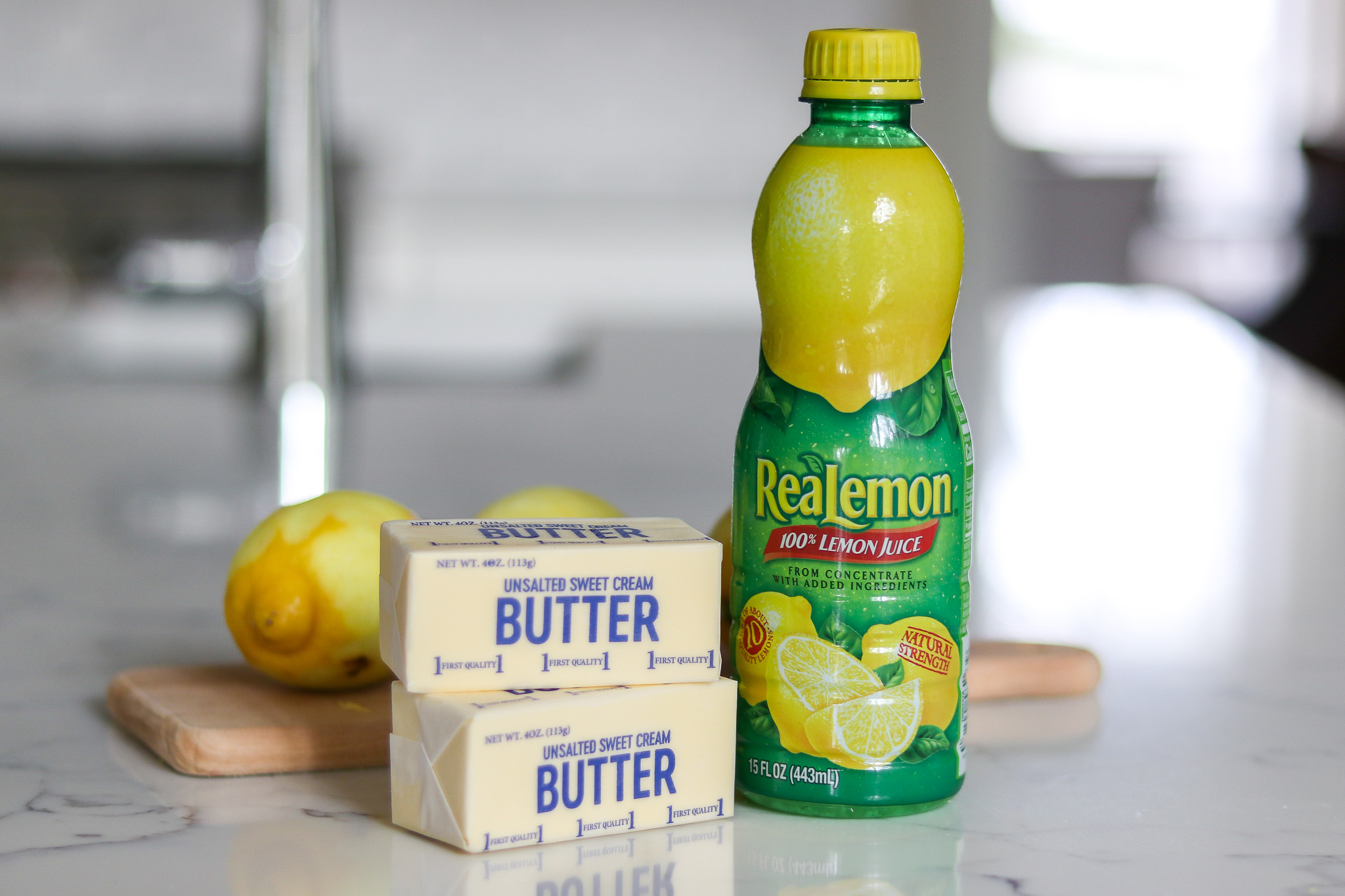
Equipment for making Lemon Curd
You will need a 1½ quart double boiler to make lemon curd. A double boiler is actually two pots – a large pot to hold water and an upper pot that sits inside the lower pot so that the upper pot never touches the stove surface but is heated by the steam from the hot water in the lower pot.
If you do not have a double boiler, you can typically improvise using two pots, one slightly smaller than the other with handles, so that the smaller pot can rest inside the larger pan but not touch the bottom.
A large microwave-safe glass bowl or Corningware can also be used as the top pot, and it is easier if it has handles or pouring spouts to help keep the pan above the water.
The double boiler is essential, as it allows you to slowly thicken the lemon curd without it curdling. Without a double boiler, you’re just going to make lemon flavored scrambled eggs, so be sure you setup a double boiler to make this recipe.
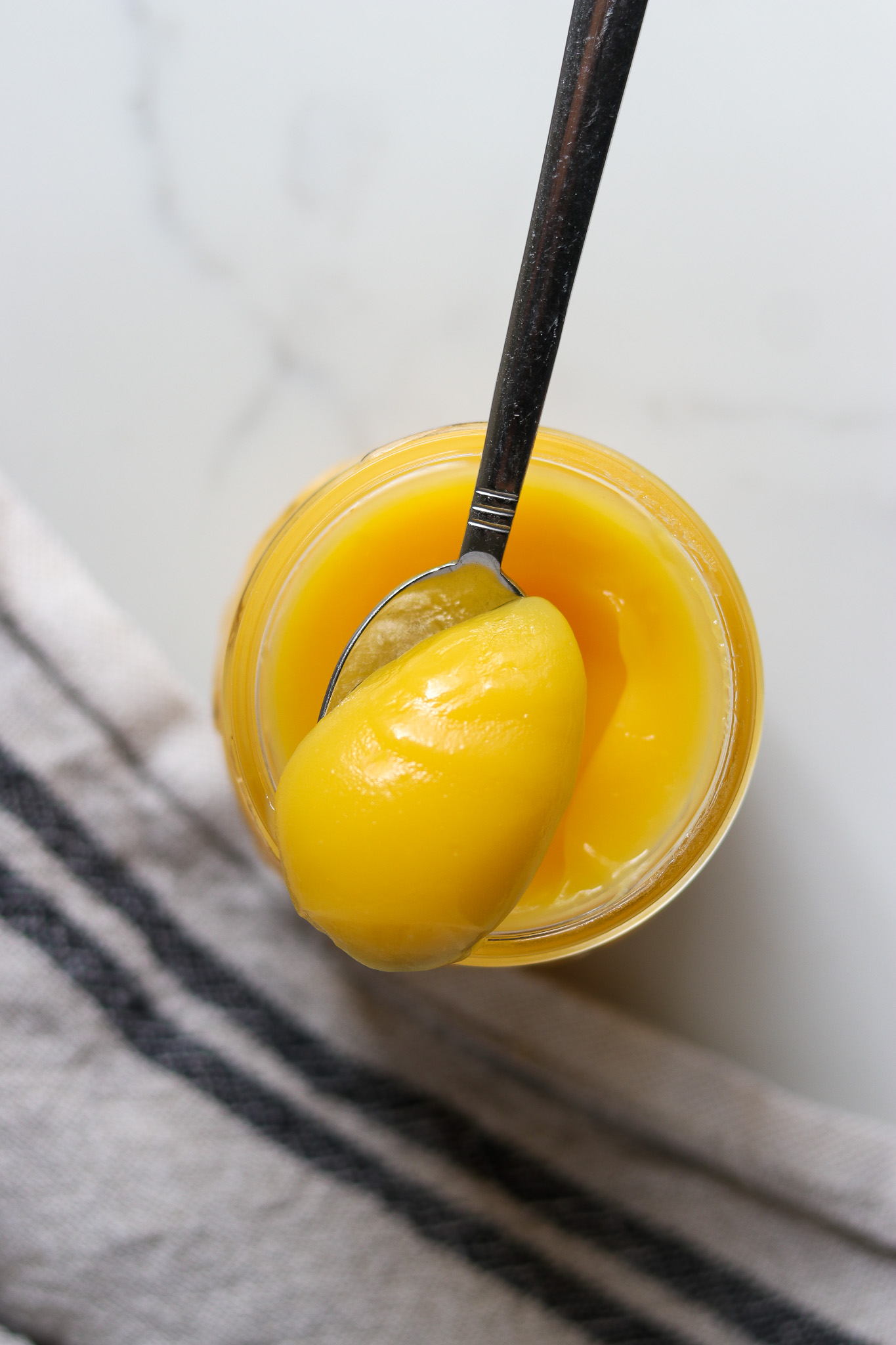
It is crucial in this recipe that the top pot, which will have the cooking ingredients, will not touch the water in the bottom pot.
The steam from the water is what you will use to cook the lemon curd. You may scorch your curd if the top pot or bowl touches the boiling water below.
The upper pot must hold at least 1½ quarts and sit high enough over the bottom pot to prevent it from touching the water.
Other equipment required for this recipe includes a zester, a whisk, a strainer, a kitchen thermometer that measures up to 170 degrees Fahrenheit or more, and a glass or stainless steel mixing bowl.

How to Make Lemon Curd
Wash the lemons with cool fresh water, rubbing the outer skin with your hands or a soft vegetable brush to remove any residue.
The USDA recommends NOT using soap, detergent, or commercially made produce and fruit wash. If you prefer, use a mixture of 2 tablespoons of baking soda and 1 cup of water and gently rub the lemons with this mixture, then rinse well in cool fresh water.
Common pesticides and other chemicals sometimes found on fruit are typically neutralized by the alkaline properties of baking soda.
Alternatively, you can buy organic lemons, which I highly recommend when working with zest. Still, it’s always a good idea to wash them well before zesting.
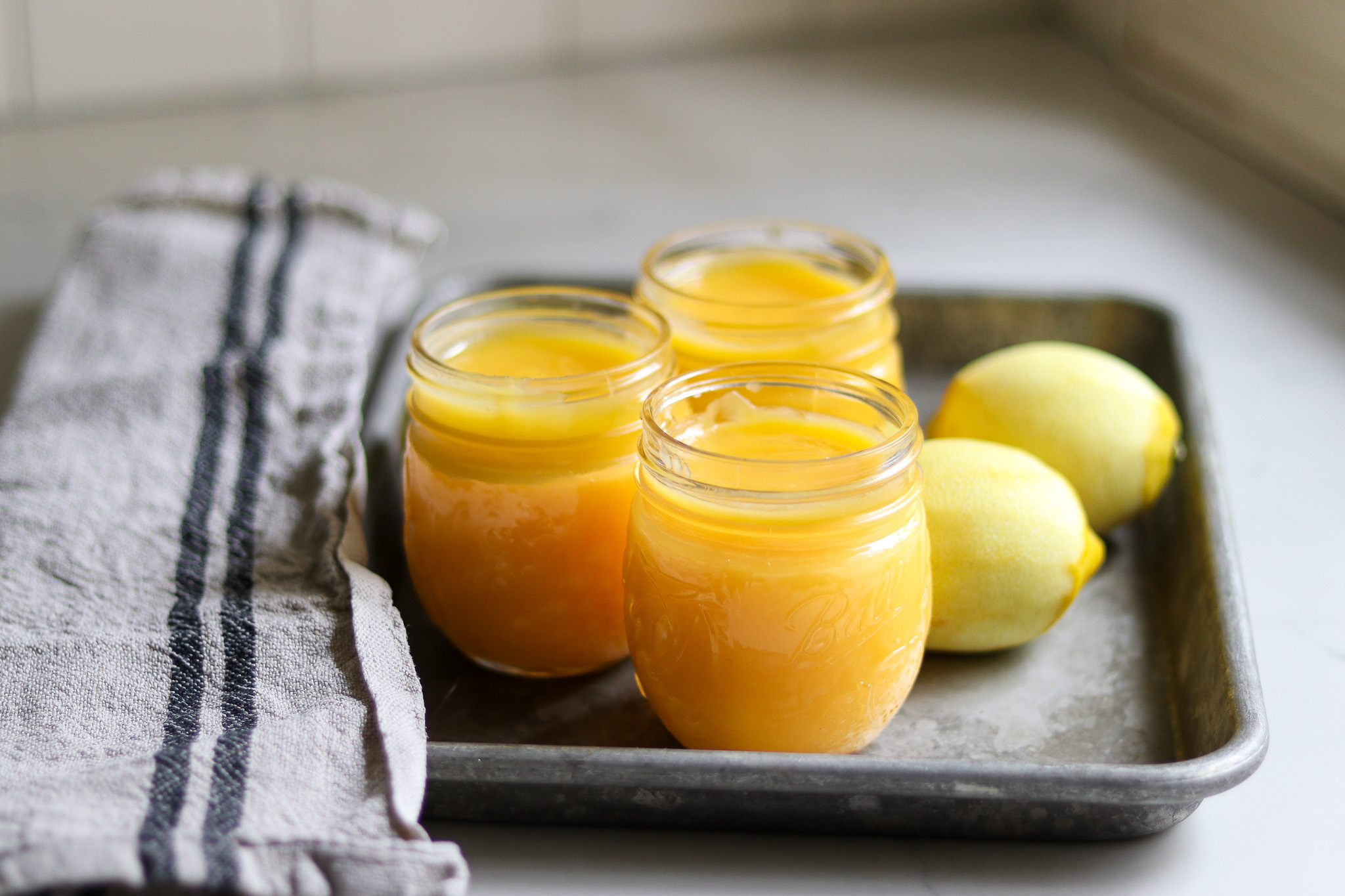
Zest the lemons using a zester or a fine cheese grater. Zest only the outer yellow layer of skin, trying not to get too much of the softer, white layer beneath the outer skin, as that layer can provide a more bitter taste.
Zest the lemons until you have ½ cup of lemon zest.
Mix 2½ cups of superfine sugar and the lemon zest in a small bowl, and stir to blend. Set this mixture aside for about 30 minutes.
The lemon zest is flavoring the sugar at this point, and helping to extract the wonderfully flavored volatile lemon oils from the zest. Giving it time with sugar before you make the preserve will help it retain flavor through the whole canning process.
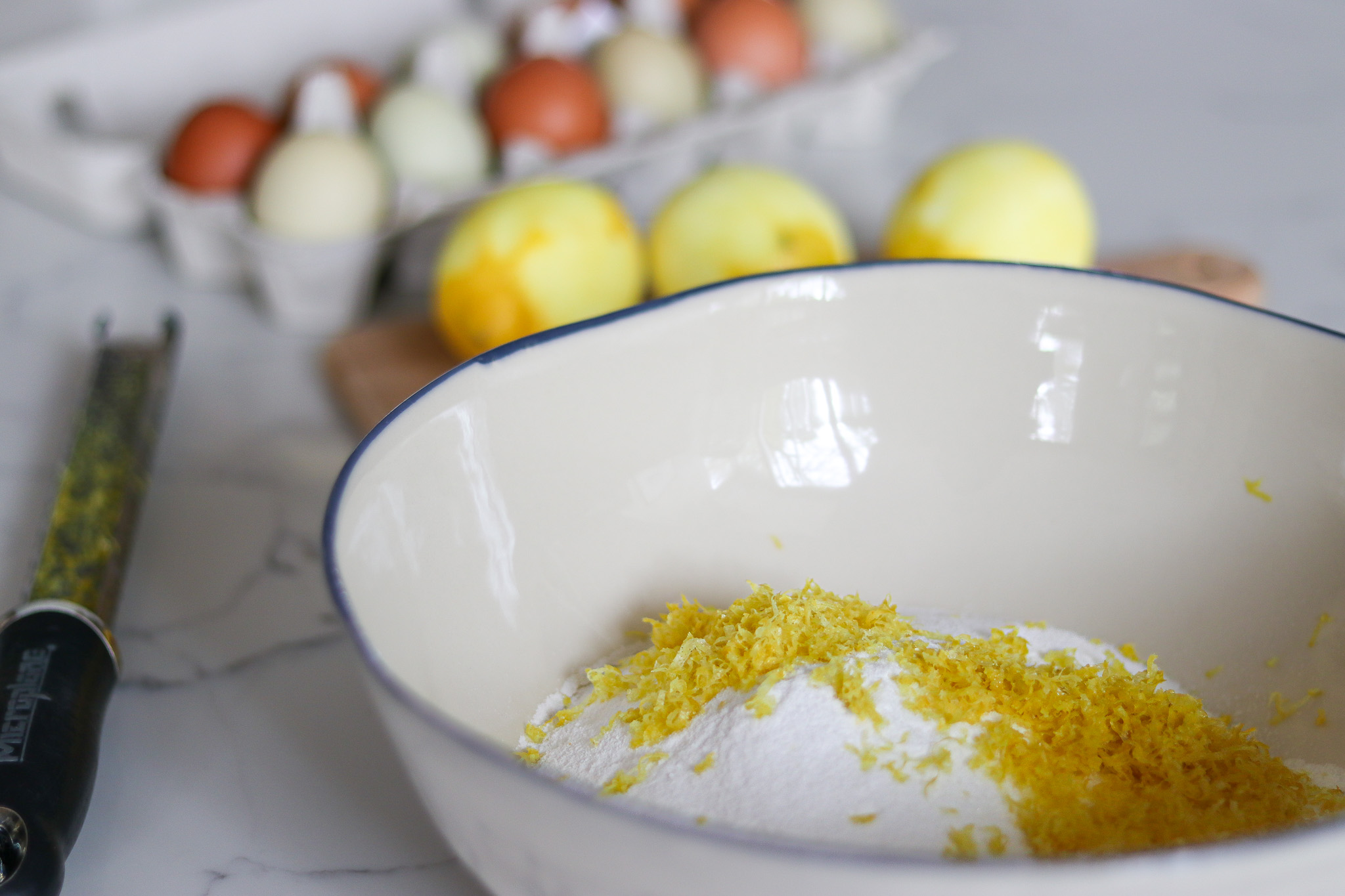
Cut the chilled butter into small pieces, no larger than ¾”, and keep refrigerated.
After the lemon zest and sugar have set for 30 minutes, place enough water in the bottom pan of the double boiler so that it will not touch the top pan but will be enough water not to evaporate too quickly. Begin to heat the water to a gentle boil.
Using the top pan of the double boiler, thoroughly whisk the egg yolks and the whole eggs until well blended.

Gradually whisk in the sugar and lemon zest mixture, maintaining a smooth texture as you mix.
Finally, blend in the lemon juice, mix well, then add the butter pieces.
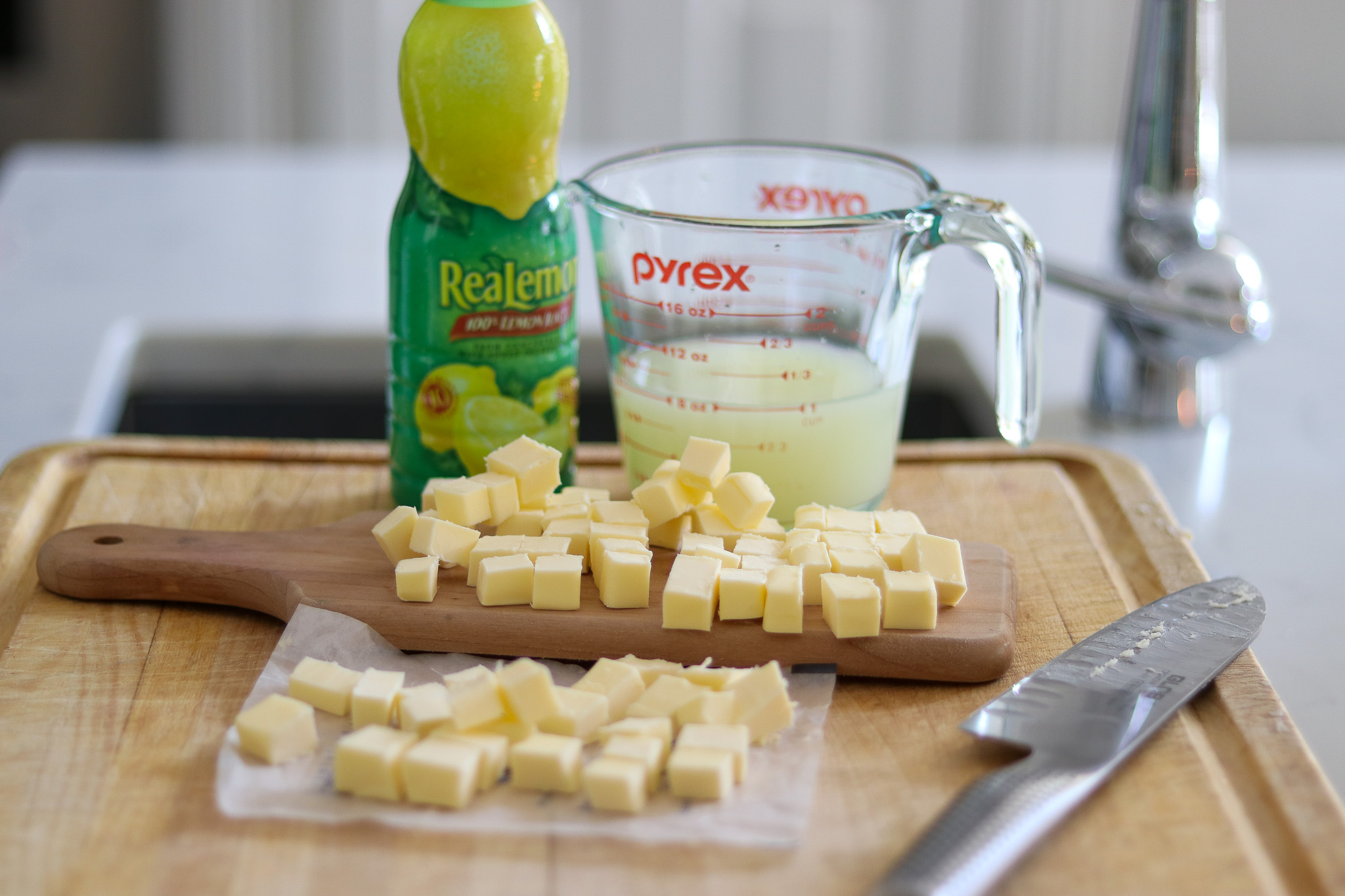
Place the top pan of the double boiler with the curd mixture over the boiling water in the bottom pan. Do not let the top pan touch the water. You will use the steam from the boiling water to cook the curd.
Stir the curd mixture continuously and gently as it heats to prevent it from sticking to the bottom of the pan. Use a silicone spatula to stir, gently scraping the bottom of the pan as you stir.
Cook the lemon mixture until it reaches a temperature of 170° Fahrenheit using your food thermometer.
Remove the top pan from the double boiler and place it on a pot holder or heat-resistant pad on the countertop.
Continue to gently stir the curd until it thickens, which should be approximately 5 minutes.
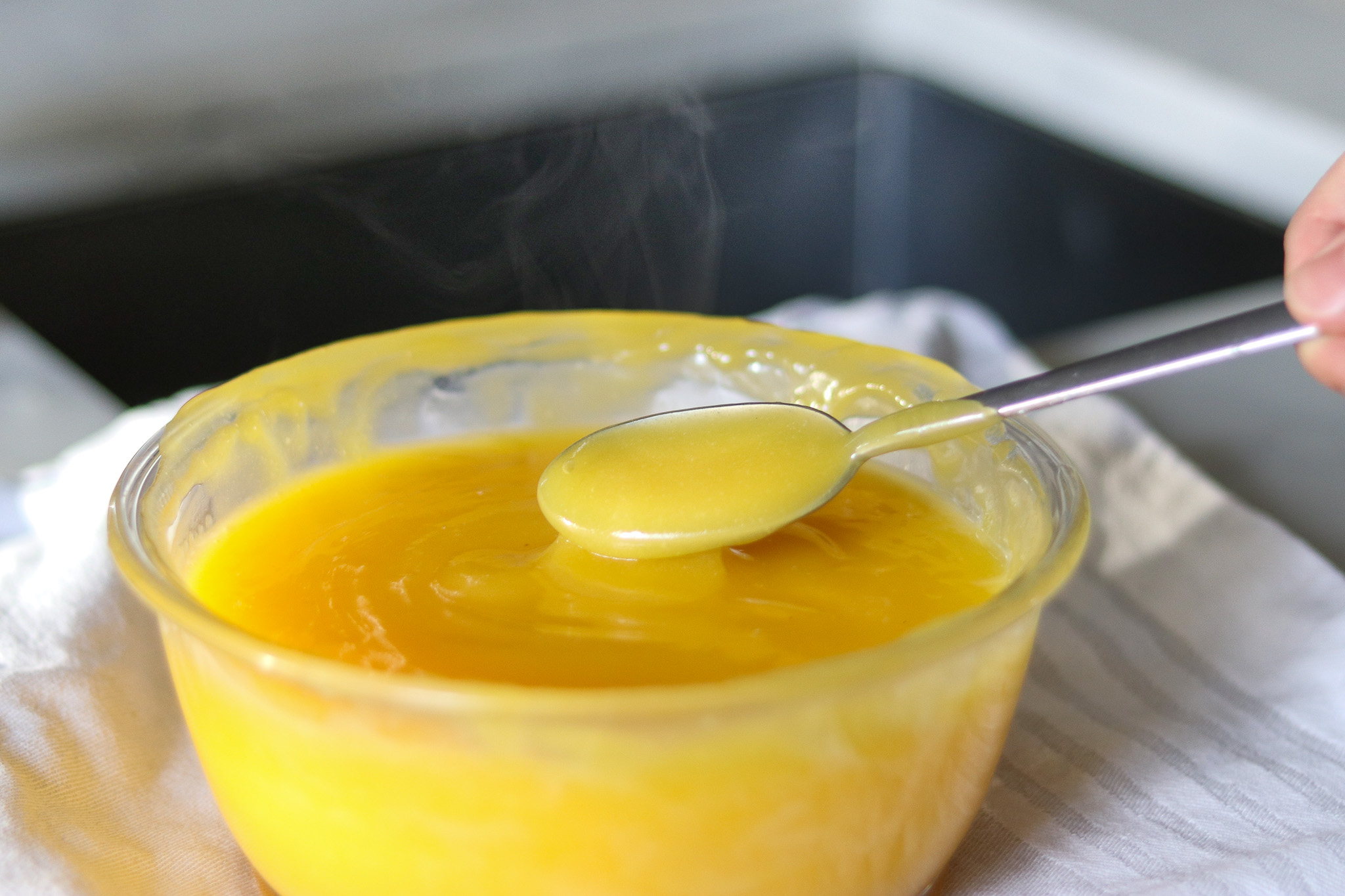
If you will be canning your curd, begin to heat the canning jars at this time.
Otherwise, prepare freezer-safe containers and lids.

Using a medium-fine mesh strainer, pour the curd mixture through the strainer into a glass or stainless-steel bowl. This process will remove the lemon zest, which should be discarded.
At this point, you have finished lemon curd, and it’s ready to go into the jars. (If you’re not canning, you can simply load it into the jars, allow it to cool completely on the counter and then store in the refrigerator or freezer).
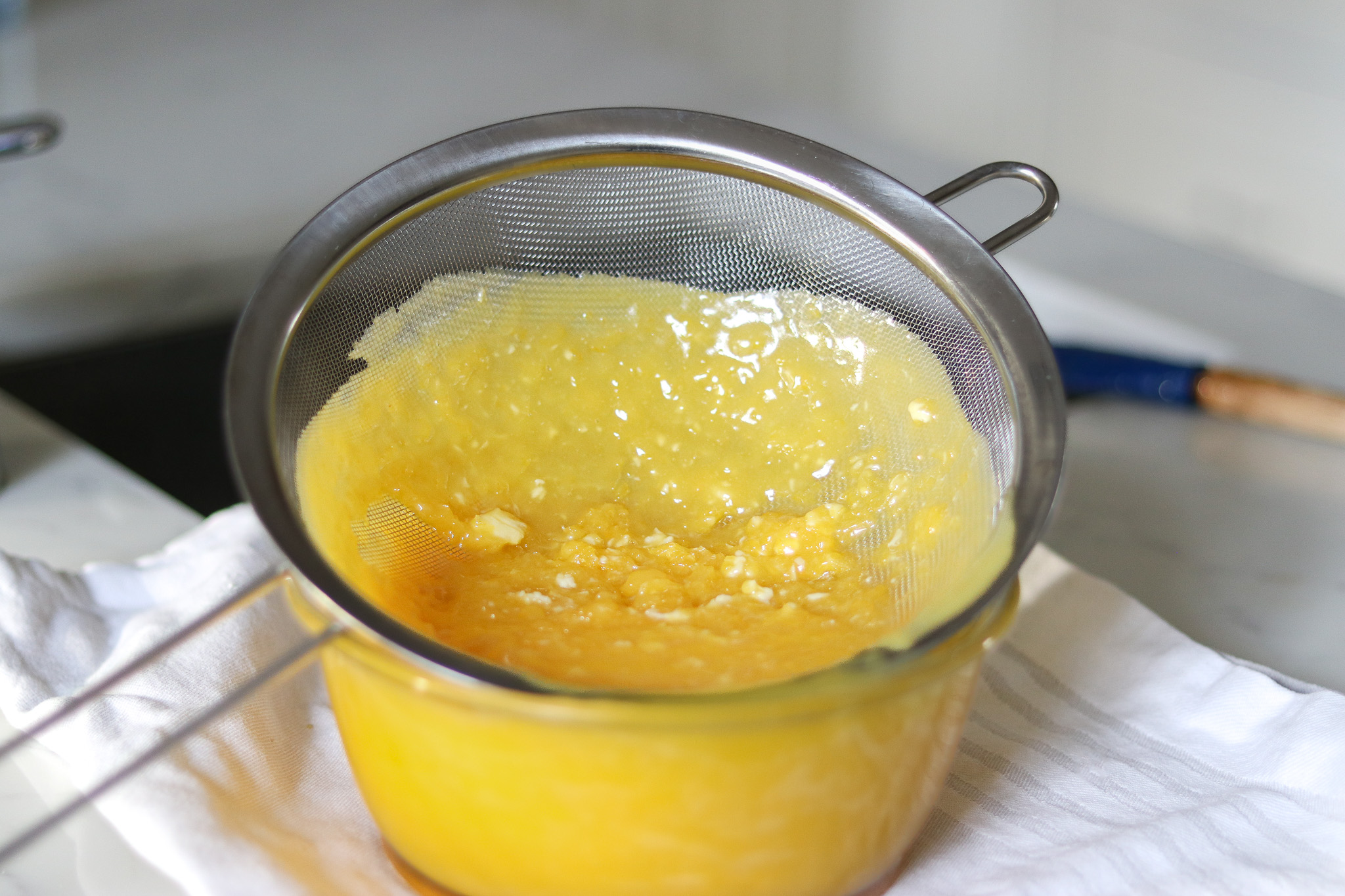
In this case, this recipe is written for canning, but canning is optional.
Lemon curd can be refrigerated after it cools and used within 4 weeks, or it can be frozen and maintain quality for up to 1 year.
After straining the zest from the curd, use freezer-safe containers to store it, allowing it to cool to room temperature before freezing. To thaw, place the frozen curd container in the refrigerator at 40° F or lower for 24 hours before using. Once frozen curd has been thawed, use it within 4 weeks for best quality.
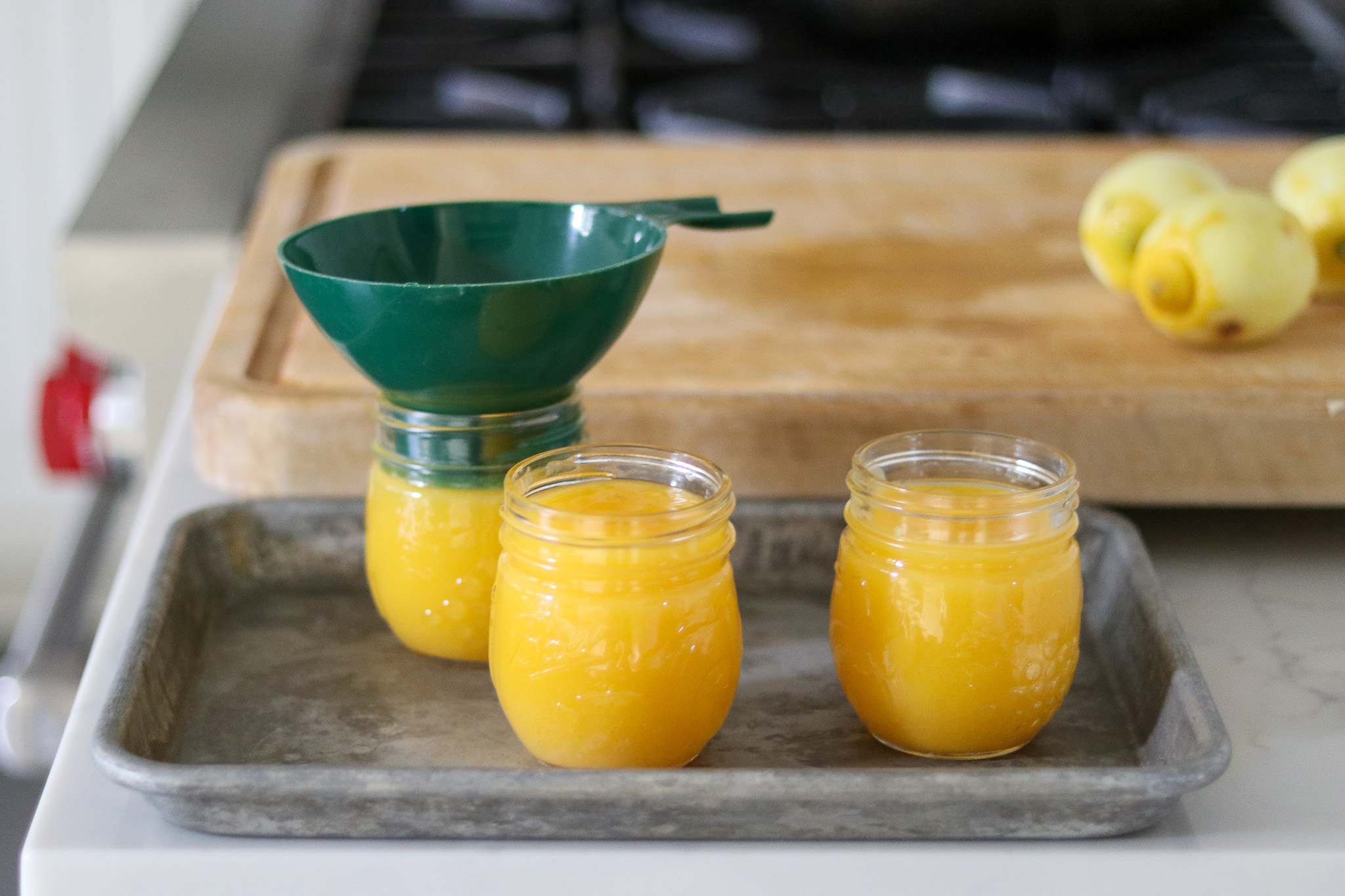
Canning Lemon Curd
Prepare a water bath canner and jars before you start cooking the curd. If you’re unfamiliar with water bath canning, please read my beginner’s guide to water bath canning before you get started.
Once the curd has thickened, strain out the zest using your mesh strainer as instructed above.
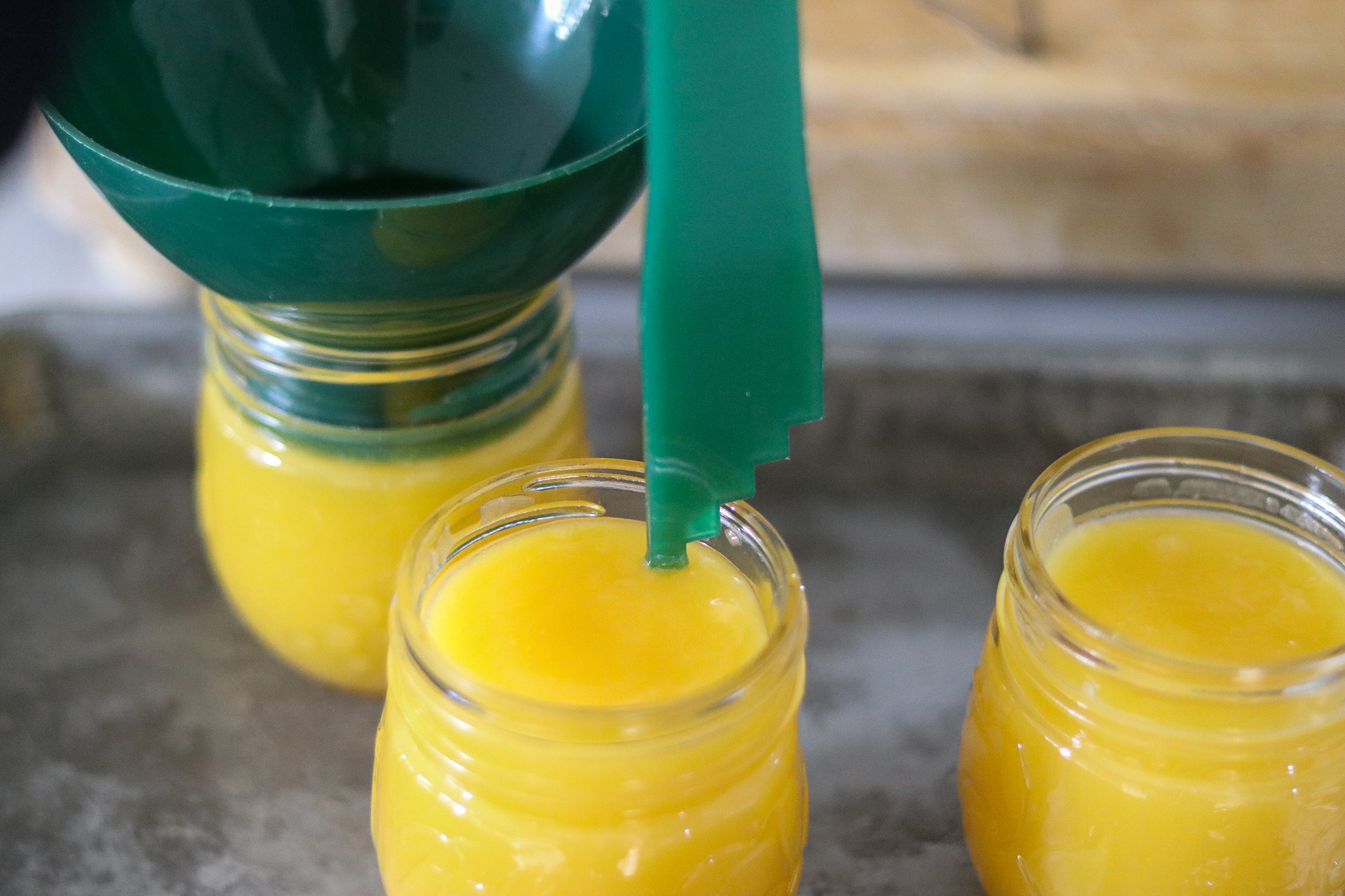
Working quickly, pour the curd into the prepared hot canning jars, leaving ½” headspace at the top. Remove any air bubbles with a spatula, and again check the headspace, ensuring the correct ½” measurement.
Wipe the rims of the jars with a clean, damp cloth, and apply the 2-part canning lids to finger-tight.
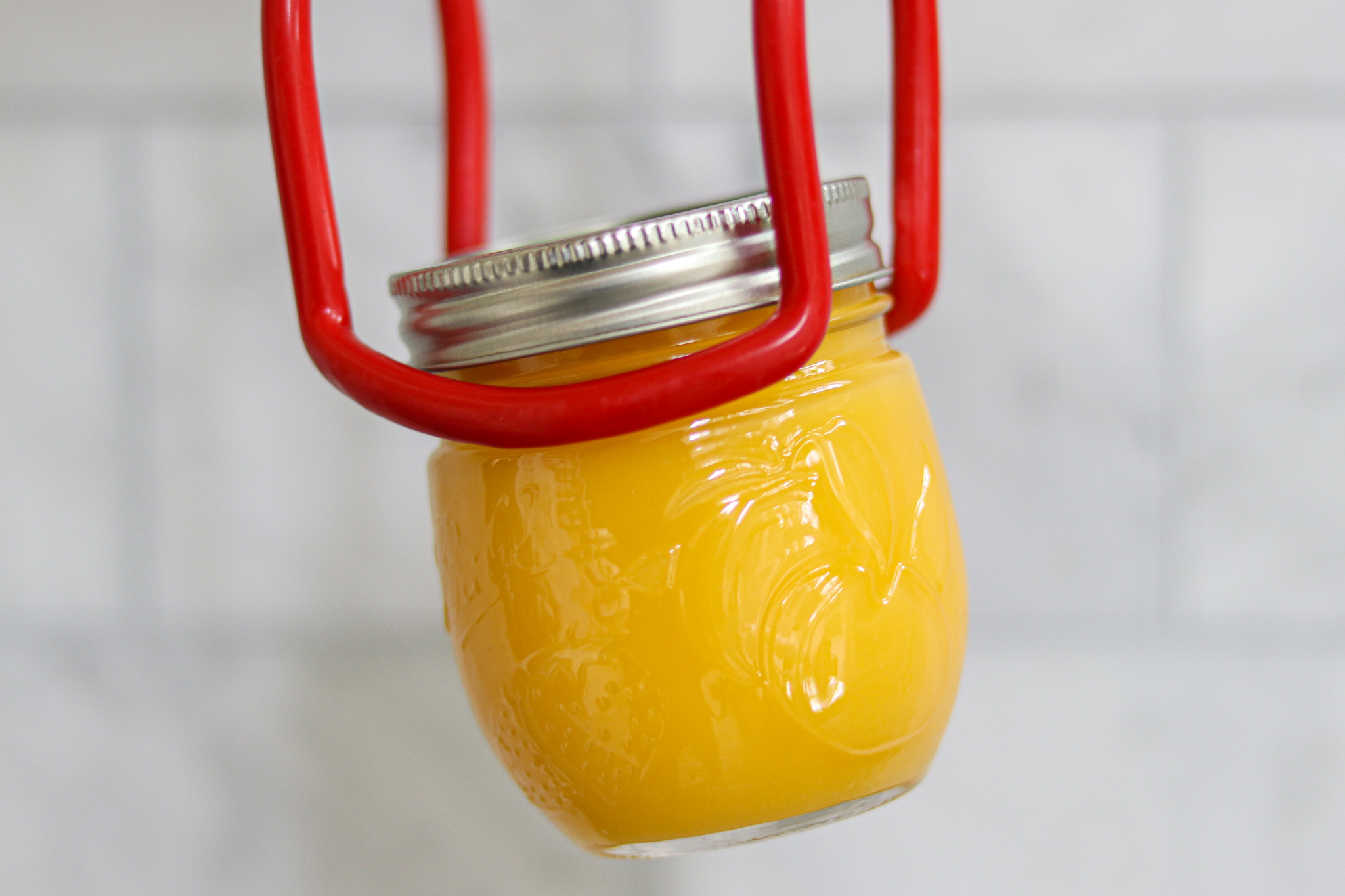
Place the filled jars into your preheated canner and bring the canner to a full rolling boil.
Once boiling, start the timer and process half-pint jars for 15 minutes if you are at an altitude of 0-1,000 feet.
For 1,001 to 6,000 feet, process for 20 minutes; above 6,000 feet, process half-pint jars for 25 minutes.
Do not can lemon curd in jars larger than half pint (8 oz).
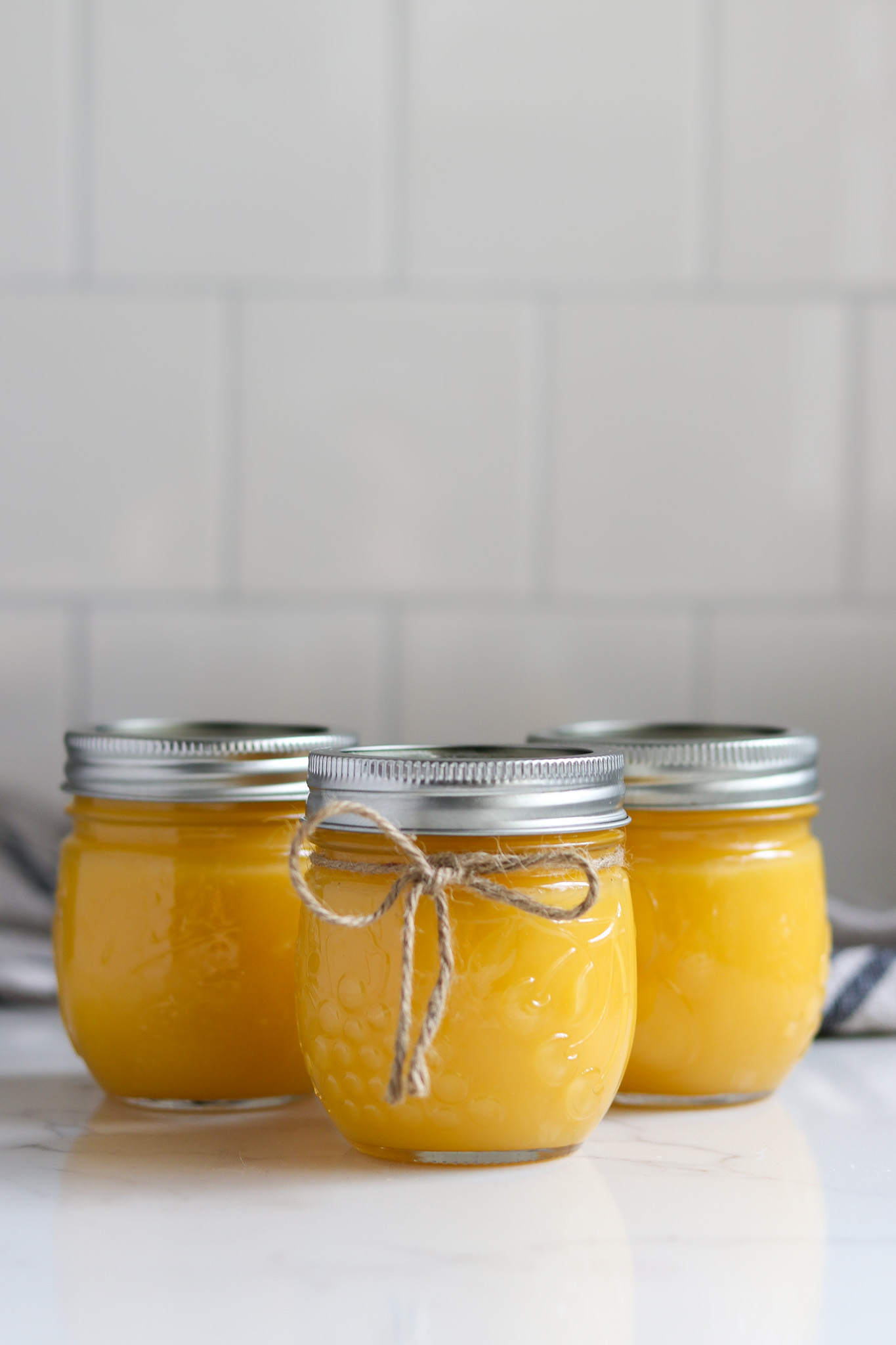
After the processing time is complete, turn off the heat and allow the jars to sit in the canner for 5-10 minutes. Then use a jar lifter to remove the jars from the canner and set them to cool, undisturbed, on a towel on the counter. Check seals after 12-24 hours and store unsealed jars in the refrigerator for immediate use.
Curd is best stored in a cool, dark place, avoiding as much light as possible. For the best quality, you should use canned lemon curd within 3 to 4 months. If stored too long, the curd may start browning, or some separation may occur, at which time the curd should be discarded.
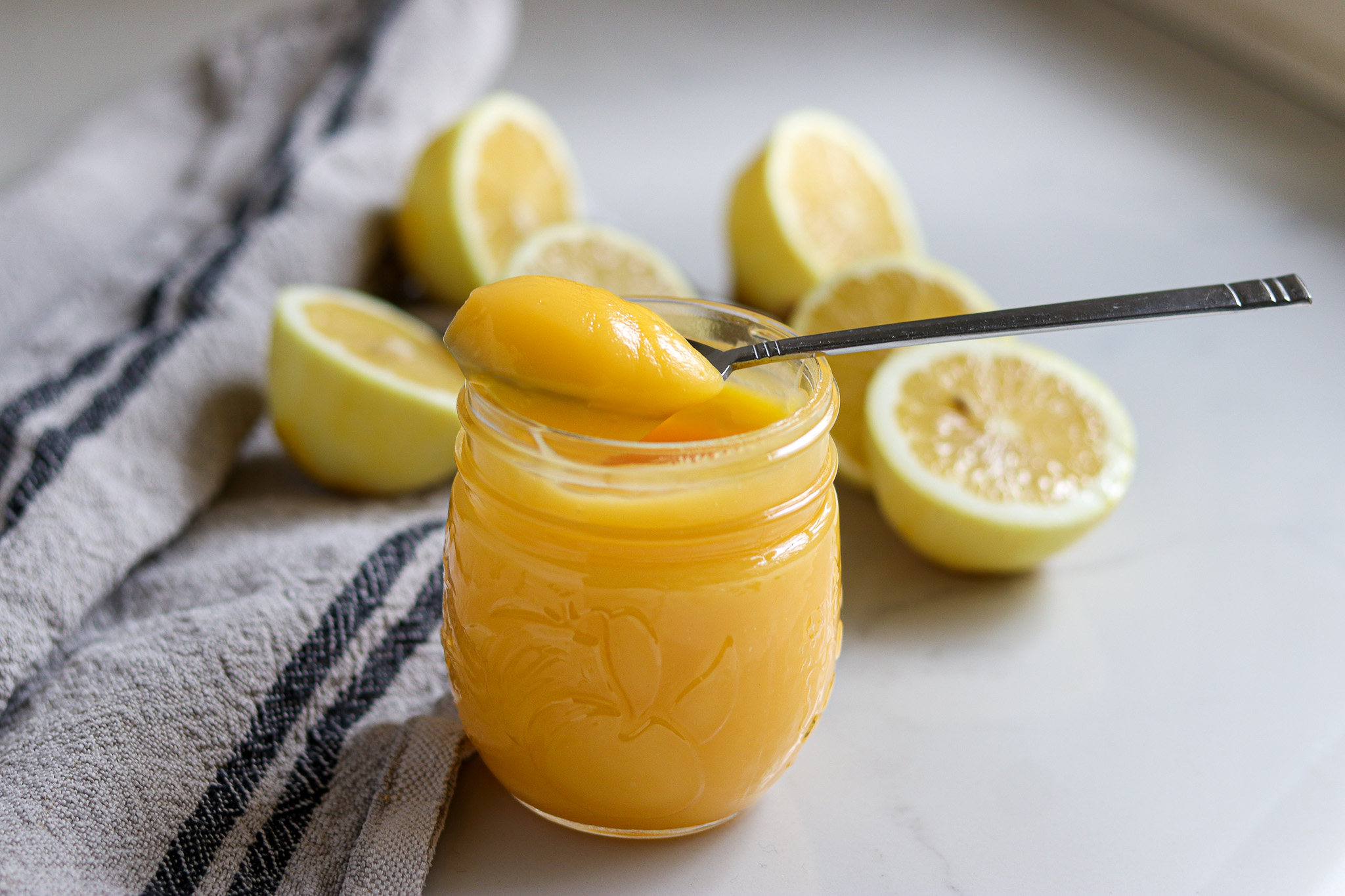
Lemon Curd Variations
Delicious lime curd can be made using this recipe, substituting bottled lime juice and fresh lime zest instead of lemon.
For a refreshing lemon-lime mixture, combine lemons and limes to create the quantities needed for the recipe.
Other citrus or fruits are not recommended to make curd for canning.
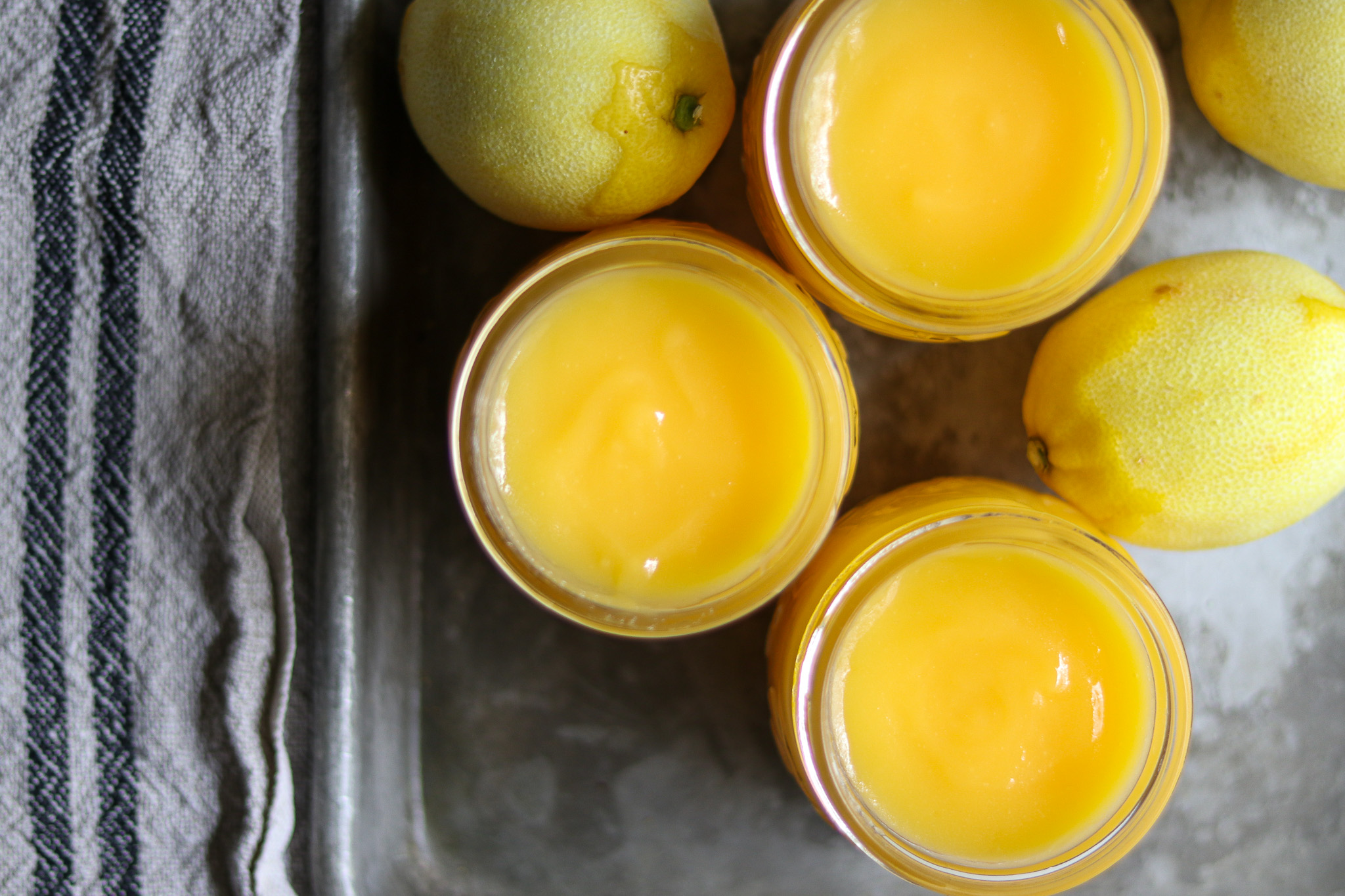
Ways to Use Lemon Curd
Lemon curd can be used in many ways, including as a filling or as a topping.
Use lemon curd as a delicious filling for tarts or crepes. It can also be used as a filling for pastries, sandwich cookies, or macarons.
Try lemon curd as a topping on ice cream or frozen yogurt.
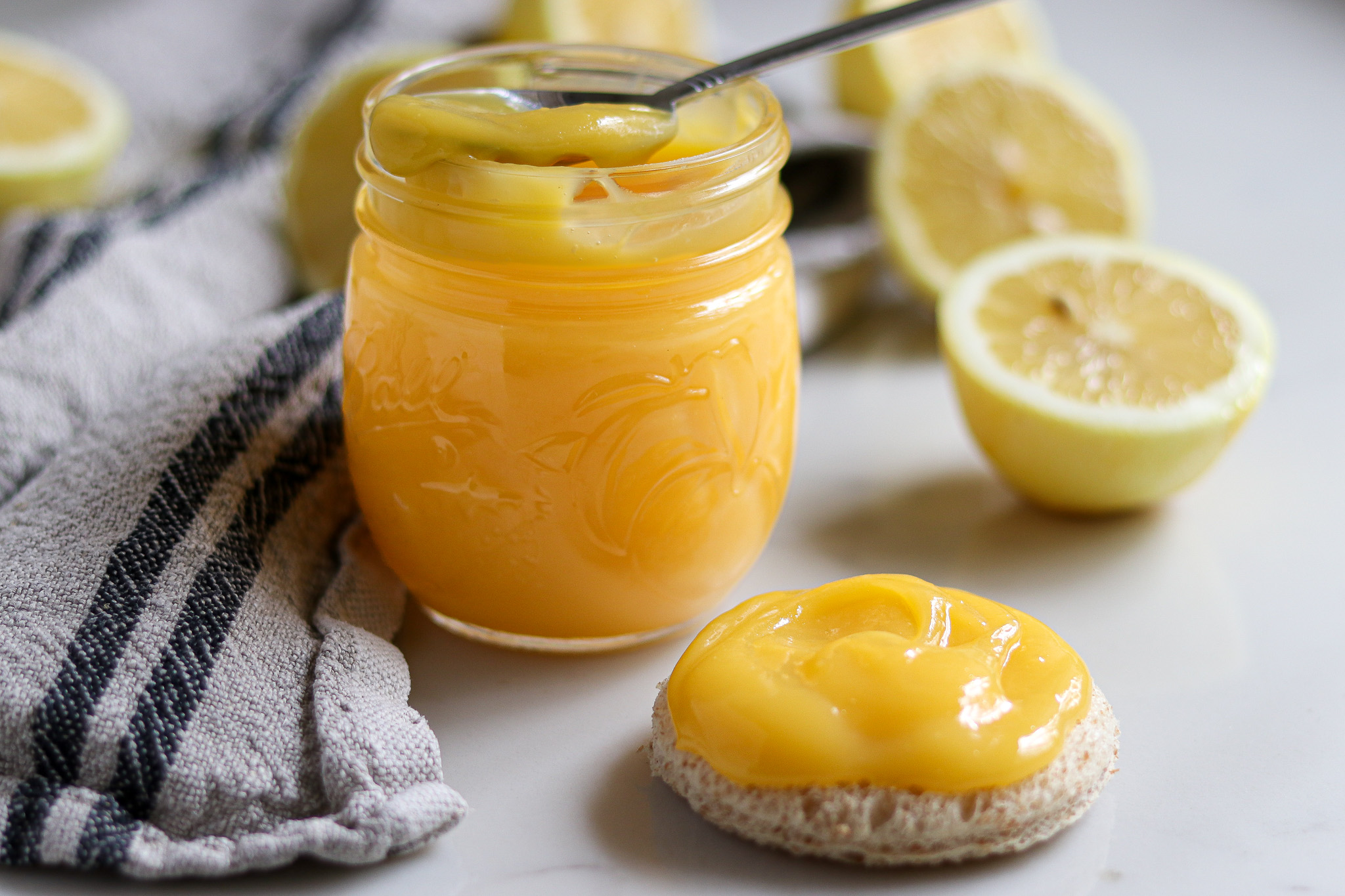
Lemon or white cake can be topped with lemon curd instead of frosting for a fantastic flavor addition. Cheesecake or other cakes are also great with a generous spoonful of lemon curd served on top.
Dip vanilla wafers or cookies in lemon curd for a new cookie experience!
Try using lemon curd instead of a cream cheese filling or frosting in your favorite desserts. Experiment with pastries, bread, cookies, and desserts to find your new favorite!
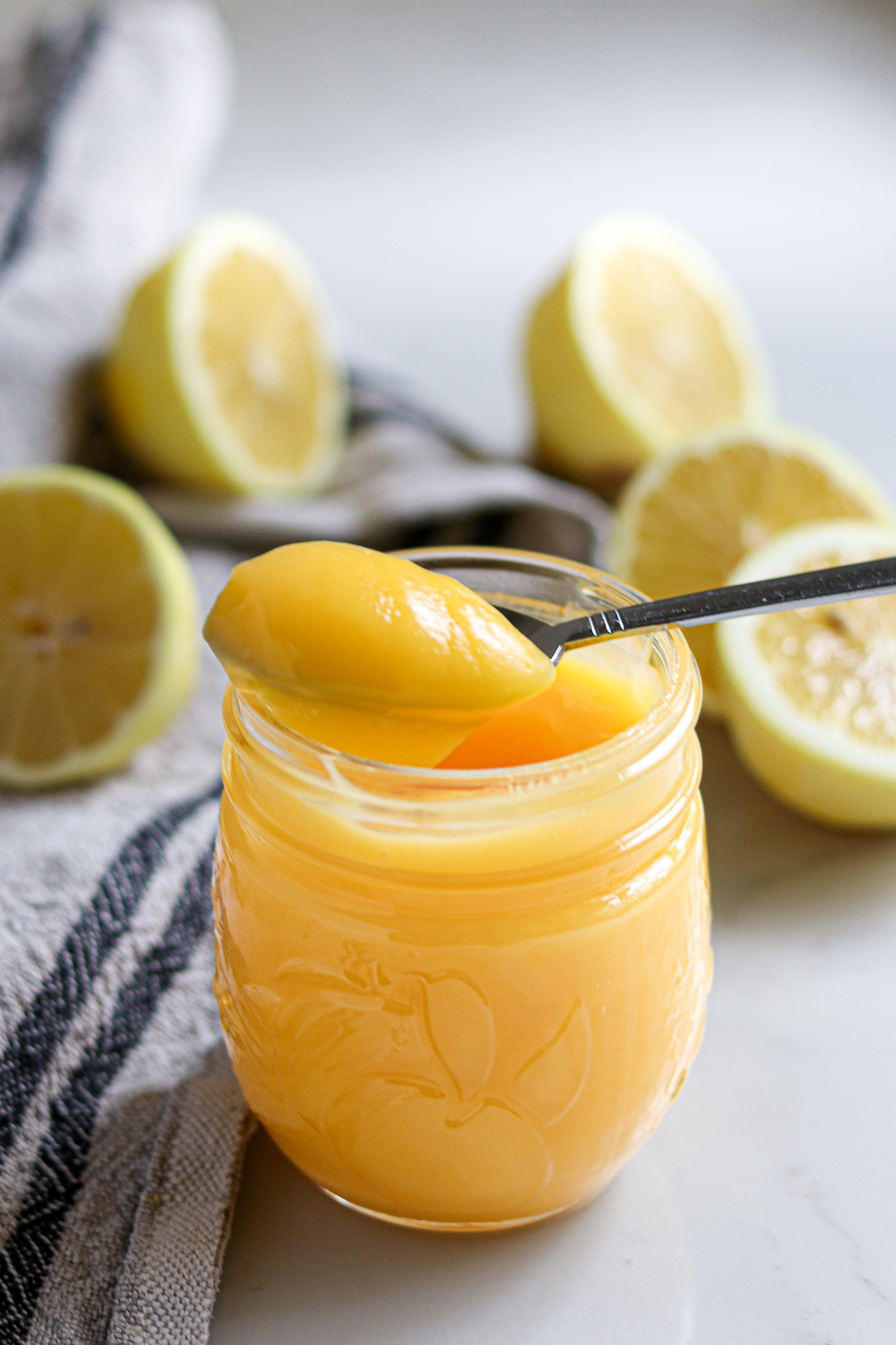
Ways to Preserve Lemons
Looking for more ways to preserve lemons?
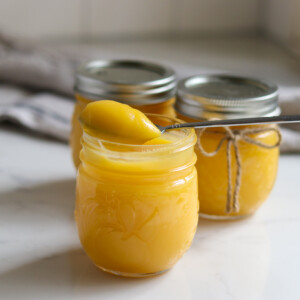
Canning Lemon Curd
Ingredients
- 2½ cups superfine sugar, see below
- ½ cup fresh lemon zest
- 1 cup bottled lemon juice
- ¾ cup unsalted butter, chilled and cut
- 7 large egg yolks
- 4 large whole eggs
Instructions
- If canning, prepare a water bath canner, jars and lids before you begin making the lemon curd.
- Wash the lemons and zest the outer skin to obtain ½ cup of zest.
- In a small bowl, combine the zest and sugar, mix well, and let set for 30 minutes.
- Prepare a double boiler and begin to heat water in the bottom pan. Ensure the water in the bottom pan will not touch the top pan of the double boiler.
- In the top pan of the double boiler, whisk together the egg yolks and whole eggs until thoroughly mixed.
- Gradually add the zest and sugar mixture and continue to whisk, maintaining a smooth texture. Blend in the lemon juice and butter pieces.
- Place the top pan with the lemon mixture over the bottom pan of the double boiler. Maintain a gentle boil in the bottom pan, allowing the steam to heat the mixture in the top pan.
- Use a silicone spatula to gently scrape the bottom of the pan to prevent sticking as the mixture cooks. Stirring continuously, heat the lemon curd mixture until it reaches 170° F on a kitchen thermometer.
- Remove the top pan from the double boiler and place it on a heat-resistant surface on the counter. Stir the curd gently until it thickens, or about 5 minutes.
- Pour the curd through a mesh strainer into a glass or stainless-steel bowl and discard the zest collected in the strainer.
- Ladle or pour the curd into hot half-pint jars or containers, leaving 1/2 inch headspace. Seal with 2 part canning lids.
- Load jars into a simmering water bath canner, and turn up the heat to bring the canner to a full rolling boil.
- Process half-pint jars for 15 minutes if you are at an altitude of 0-1,000 feet. For 1,001 to 6,000 feet, process for 20 minutes; above 6,000 feet, process half-pint jars for 25 minutes. Do not can lemon curd in jars larger than half pint (8 oz).
- After the canning time is complete, turn off the heat and allow the jars to sit in the canner for another 5 minutes before removing them to cool completely on a towel on the counter.
- Store preserved jars of curd in a cool, dark place such as a pantry shelf and use within 3 to 4 months. Discard if browning or separation occurs.
Notes
Nutrition
Nutrition information is automatically calculated, so should only be used as an approximation.
Citrus Canning Recipes
There’s more than one way to put citrus in a jar!
- Low Sugar Orange Marmalade
- Lime Marmalade
- Canning Limeade Concentrate
- Cherry Limeade Concentrate
- Watermelon Lemonade Concentrate
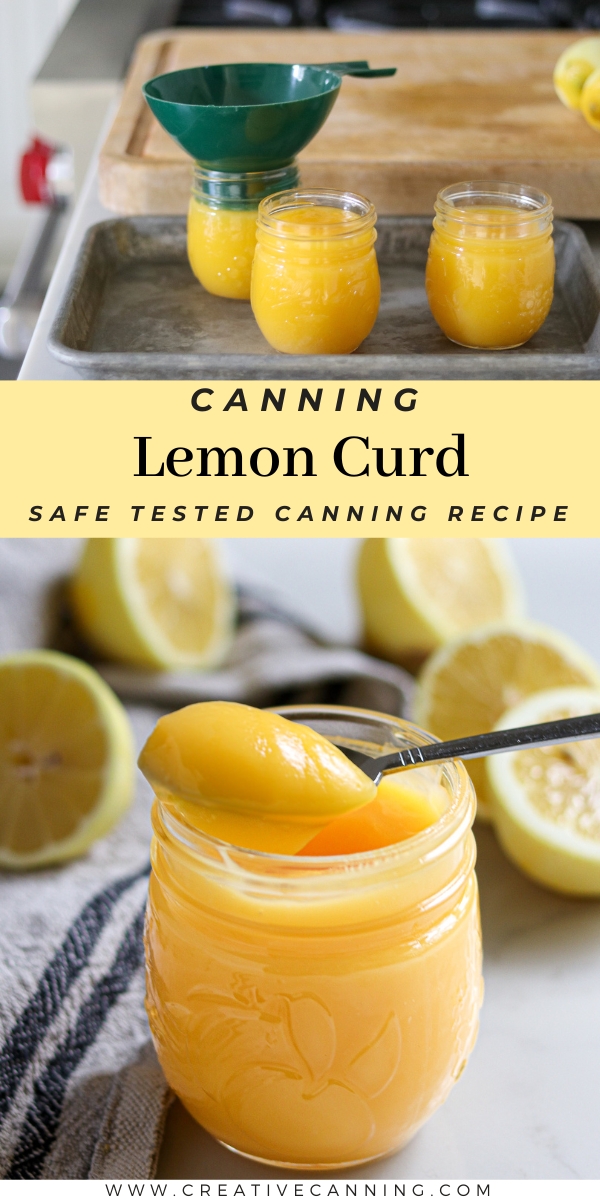

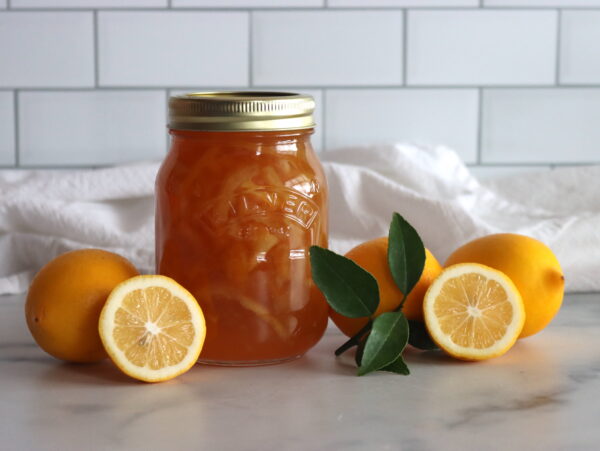
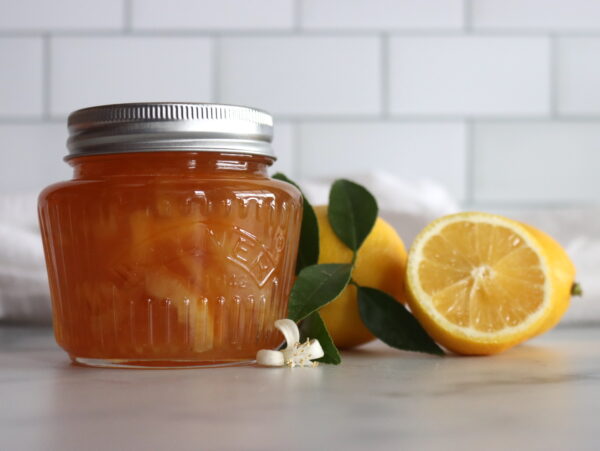
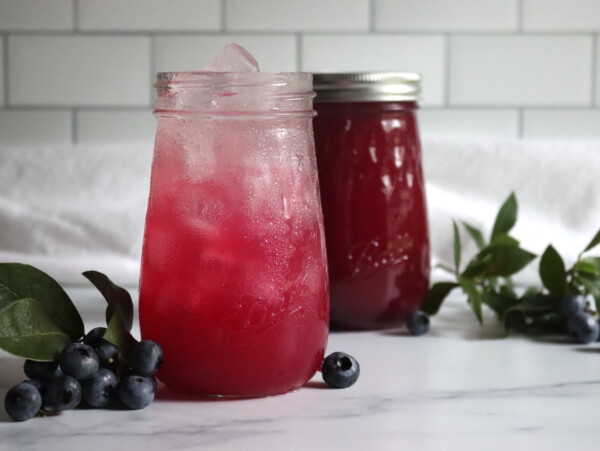
Will this recipe work using lemon essential oil in place of lemon zest?
If you have food grade lemon oil or lemon extract, yes, you can use that in place of the zest. You’d need very little, maybe a drop or two if it’s pure lemon oil, possibly as much as 1 tsp if its lemon extract which is less concentrated. You’ll have to play around with quantities, but you can add a drop at a time, stir it in and taste test it before you ladle the batch into canning jars. Enjoy!
Is this recipe more tart or sweet?
This recipe comes out pretty sweet to my taste.
I made this recipe using Persian limes. I tripled the recipe—hallelujah! No regrets, just 12 half pints tucked away in my pantry, and a bonus pint in my fridge. Thank you so much for this fabulous recipe!
Nice! So glad you enjoyed it!
I understand that bottled lemon juice guarantees adequate acidity, but I’m curious, what if you were to pH test fresh lemon juice to verify the acidity? If it weren’t acidic enough, couldn’t citric acid be added to make it a safe pH?
That certainly makes sense. The thing is, while everyone says “bottled lemon juice is at a standard acidity” I can’t find anywhere that actually states what that acidity is. The only things I can find say that it’s somewhere between a pH of 2.0 and 2.8, which is hardly a standard as those are very different measurements. I don’t know what acidity you’d need to target if you were to measure it, and looking at extension canning forums, it seems like the “authorities” on the subject don’t either. If you happen to find anything definitive, please do let me know, as this is a question I’d personally love to have the answer to.
(Hmm, it occurs to me, I should probably buy like 10 different bottles of lemon juice and use a pH meter to check them. It’d be funny if they all came out different and the “standard acidity” thing was just something that has been perpetuated forever without much basis in truth. Who knows.)
Sorry I don’t have a definitive answer for you here.
Hello, Can use the Ball Easy Canner Electric Water Bath Canner? If so what settings do I use? they don’t show the temperature. Thank you
I would think that canner would be fine, but I honestly don’t know as I’ve never used it (and I have no idea what settings it has). Sorry I can’t be more help here, but I haven’t personally used that appliance.
I must watch my sugar intake due to being prediabetic. Can this and your other canning recipes substitute monk sugar for regular sugar?
To the best of my knowledge, what’s making this safe for canning is the acidity (ie. lots of lemon juice). I believe it’d still be safe for canning without regular sugar, but I can’t find anything to confirm that.
Utah State University says taht using artificial sweeteners will not work because it won’t give you the right flavor and texture…which is clearly true, they do change the flavor and texture because they don’t cook like regular sugar…but anyone who uses them is used to that. They say nothing about canning safety.
I would think you could use monkfruit without issue, but in that case, you might want to freeze it instead of canning just to be extra sure.
Here’s the link to the Utah State University extension page that talks about it. I wish I could find a better resource for you, but this is all that’s out there on the internet regarding this topic for now: https://extension.usu.edu/preserve-the-harvest/research/canning-lemon-lime-curd